A few weeks ago, I, along with fellow Punished Backlog writers David Silbert and Kei Isobe, decided to see Paul Thomas Anderson’s latest film, One Battle After Another. We made an unconventional decision to see it at the Coolidge Corner Theater in Brookline, MA, as it is one of only three cinemas in the country capable of showing the film in its native VistaVision. I know, I know, this isn’t a movie review, but before we go any further: This was a masterpiece, 10/10, one of the funniest movies I’ve seen in years. If I were you, I would put down my phone right now, save this article for later, and go see this movie. Trust me, it’s worth it.
Anyway, back on topic. The theater was worth the 15-minute drive for me, as the format was special and made me happy to watch a great movie in such a unique way. At this point you’re probably wondering: What does this have to do with Subway Builder, a new early access train game that captured a corner of the internet’s obsession? Well, usually when I go to the movies, I take a 10- to 15-minute ride on Boston’s Green Line right from my door to TD Garden. No driving, no parking, in and out.
Brookline is not all that far from my apartment in Somerville. It’s basically just over the river. Here’s the dilemma: There is no route on the MBTA that takes me to the Coolidge Corner stop without going into Boston and back. It’s easier to just drive and sit through dozens of traffic lights and angry drivers. And trust me, if the “T” (as we Bostonians call it) says it’s only 45 minutes to get through the city, it’ll be at least an hour.

This trip to the movies inspired me. I knew there was an exciting new game, Subway Builder, coming out days later. And I was going to use it to answer the great public transit question of our age: What if there was a train that took me from my house to all of my friends’ houses? (And various other locations… cough cough… the Coolidge Corner Theater.)
Now, after sinking my teeth into the game, I can confidently say that Subway Builder is a game I cannot put down. It isn’t just entertaining; it has challenged me to meet public demand and run a budget as I seek to turn America’s biggest cities into public transit utopias. It also serves as a stark reminder of a world that still can be.
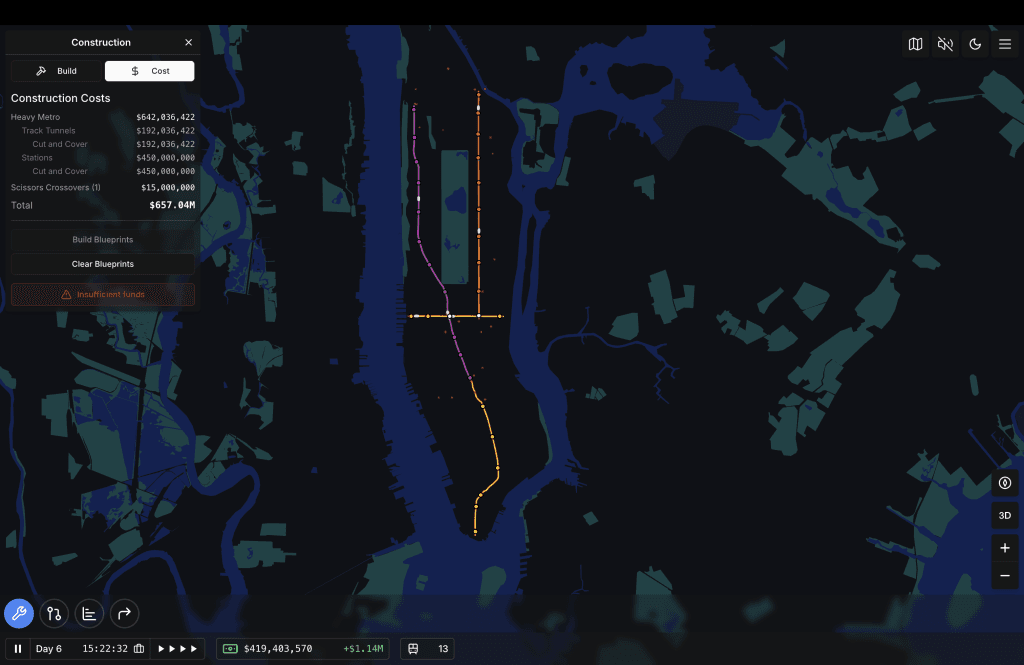
Train Tracks in the Sandbox
Subway Builder has two modes: normal mode, which starts you off with a $3 billion budget to build a realistic subway system, and sandbox mode, where you get a blank check and can go wild. At the time of writing, the game contains 26 maps of major cities across America. From my home of Boston and other older, more walkable East Coast cities, to the more car-centric cities of Houston and Dallas, this game has a challenge for everyone. You can even build a subway system for Honolulu! For review purposes, I started simple with America’s most transit-oriented city: New York. I did a quick trip to sandbox mode to learn the basics before moving to a budgeted build of the, ahem, casual challenge of a new New York City subway.
The game includes a brief tutorial to help prospective designers learn the lay of the land. Personally, I found it only moderately helpful; I was still a bit confused by the end of it. Thankfully, Subway Builder does a great job of clearly letting players know what works and what doesn’t so that they can efficiently build accurate train lines. At the end of the day, you can only learn one way, and that way is to get building.
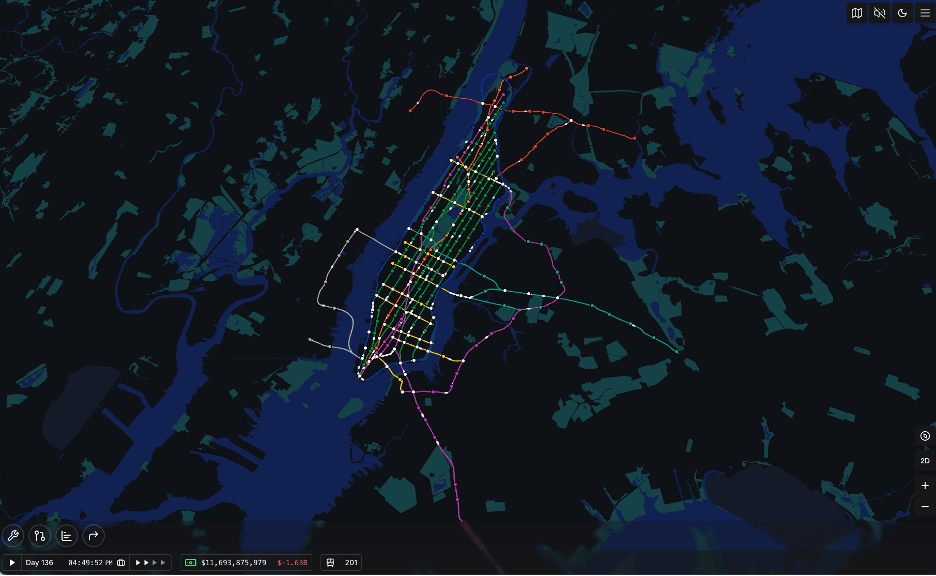
The Gilded Age of Trains
The constraints are simple and become evident quickly: Start with stations, then add tracks. Add some depth for crossing tracks, and you’re off. Just don’t try to build over existing buildings — Subway Builder generates its world map from real life data, meaning you can’t just bulldoze everything in your path, or else you’ll be millions in the hole before you know it. I learned this the hard way when I immediately tried to build a simple line down Park Ave… Grand Central Station sits right in the way, and it costs a whopping $2.3B to clear a path. Alas, I had to find another way.
My newfound nemesis taught me a valuable lesson, though, as it challenged me to build creative paths across Manhattan to get around existing buildings so I could grow revenue to the point where I could build over it. And that’s where the real gameplay starts: Once you have the feel for the buildout, it quickly becomes time to develop a system that works.
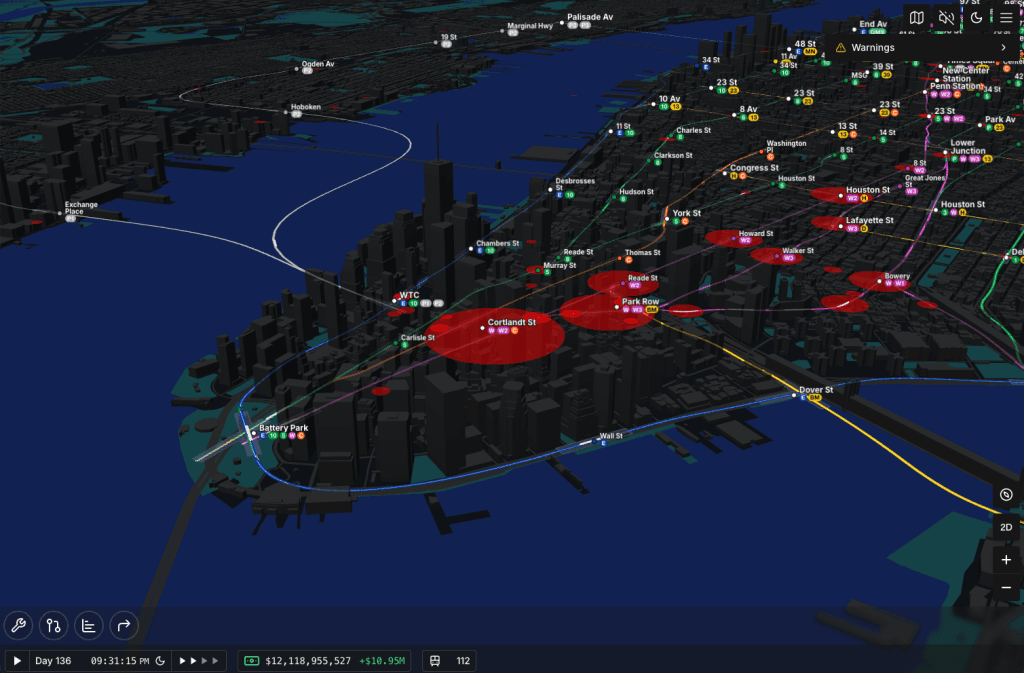
As for its overall aesthetic, Subway Builder takes a minimalist visual approach that it knocks out of the park. Its real-life map contains every street and building you could see in person, and even offers the ability to shift to a 3D model to really take in any given city’s skyline (okay, so the 3D models are mostly square, but they give you a great idea of where you are). Players can set up custom tracks from 15 colors to send trains along any route they please, and you can even customize the line names and logo shapes. The game also offers players a choice of light or dark mode; I personally prefer dark mode, as it’s what really lets the colors of the rail lines pop.
From there, even more possibilities stem: You can build single, dual, and quad tracks with different style trains, but for the purposes of this review, I stuck with a simple two-way system. I quickly found myself grouping lines by borough and direction: Vertical Manhattan lines were green and named for their long avenues, while horizontal connectors were yellow and numbered for their respective streets. Players can also customize station names and hubs. Yes, I had to build a “New Central Station” to accommodate my Grand Central issue; however, it is newer and more central, so I think it’s a hit. The 50,000 daily riders who make it my most popular station seem to agree!
A Train for Everyone
Simulator games often challenge the player to build routes so that people get where they need to be as efficiently as possible. This extends far beyond Subway Builder, as games such as Planet Zoo require a similar level of intricate planning. You can’t just build something because it looks cool. It needs utility, too.
Subway Builder has an ingenious way to display this by leveraging “Demand Stats” as a core component of its gameplay. The player’s job isn’t just to build a system that works, but rather to build one with a strategic focus on guiding a city’s population to choose public transit and walking over driving. In essence, cars are the final boss of Subway Builder.
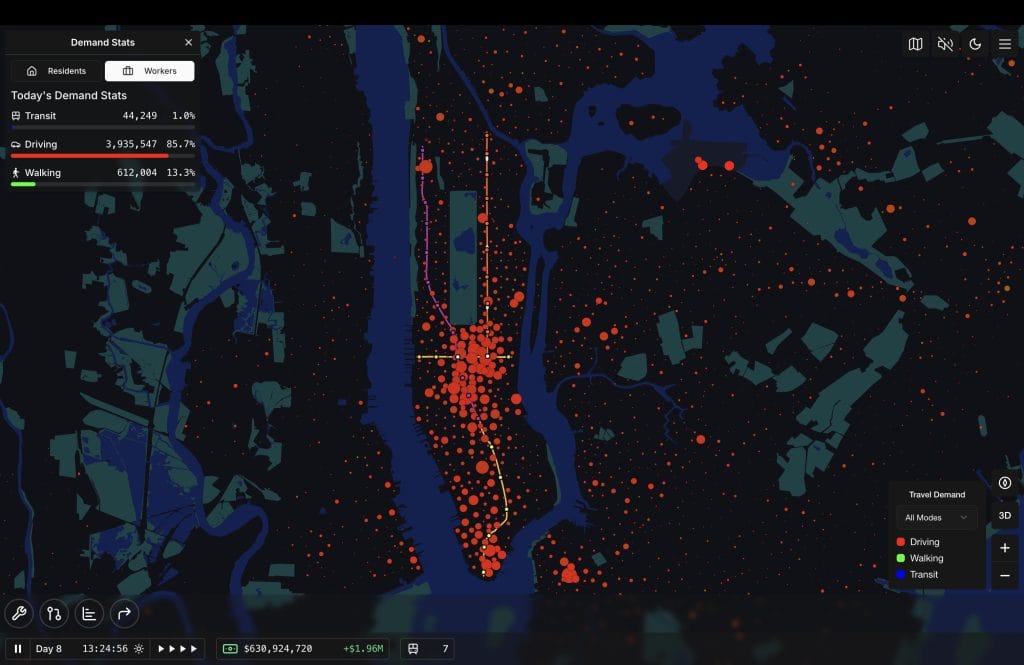
The challenge feels impossible at first. New York’s map is littered with dots that display “residential populations” from Long Island to New Jersey. It’s a huge scale to cover. Making things even more interesting, the “worker population” is almost entirely centered on Midtown and Lower Manhattan, meaning the player has to find a way to get the entire region into those two areas via train instead of car — a truly daunting task for an economy that has relied on the Lincoln Tunnel for decades.
Thankfully, Subway Builder makes it easy to track progress. Population bubbles that are more car-centric are red, and those that use transit turn blue. It is absolutely thrilling to build a new rail line and start to see those red bubbles change colors. I slowly turned Manhattan’s residential population demand from a sea of red into a rainbow after 100 in-game days. With a line on just about every other vertical street to bring riders up and down the island in minutes, it was clear the people of Manhattan appreciated my work.

The worker demand, on the other hand, is another challenge entirely. While I have succeeded in bringing transit to Midtown and Lower Manhattan, there are still millions of underserved people throughout the boroughs and New Jersey who are driving. But this is what makes Subway Builder such a great simulator: It does not gift the player the chance to skip out on the little guy.
Yes, everyone wants to build a subway to get to their favorite spots in Manhattan with ease, but you can’t forget the woman in Queens who needs to get to Lower Manhattan for her 9-5, or the fresh college graduates over in Hoboken who can’t wait for another thrilling day of consulting at a Big Four firm in Midtown. (You can’t get THAT granular, but it was easy for me to imagine the lives of those dots.) The demand is all over, and you cannot defeat cars until you accommodate everyone.
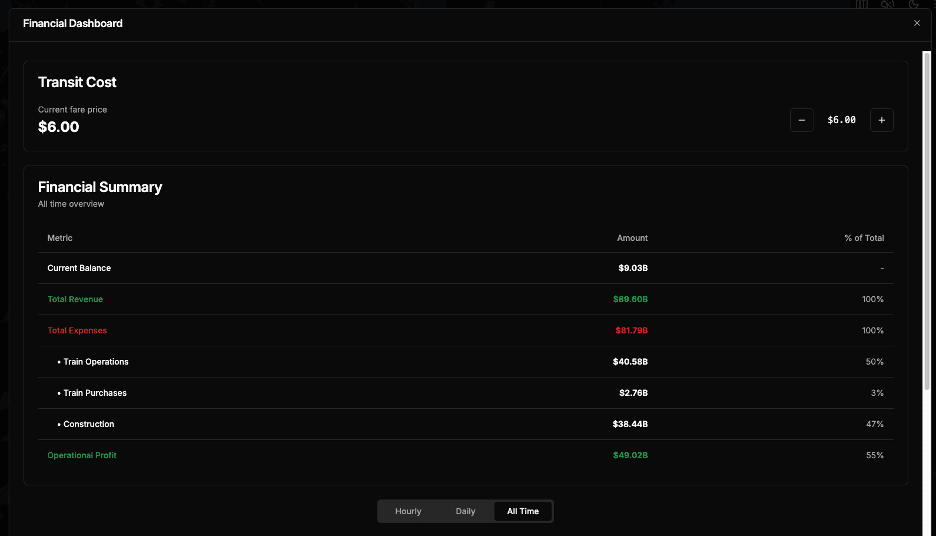
Finally, I’d be remiss not to mention the Financial Dashboard. Subway Builder makes sure not to overwhelm you with the revenue flows here — everything is easy to read and follow. You can read your total revenue by the day, two weeks, or all time to track your success, and it even breaks it down to show your operational profit. There are some handy charts included as well that really show how successful your project has been (hint: Public transit is a money maker!). What’s really fun is you can even set ticket prices… Just don’t go too crazy with it, because I tried this and the population did NOT like it.
Mind the Gap
All that being said, Subway Builder has not been without a few gameplay quirks that I’d love to see resolved for its final release. The Demand Stats, for example, are extremely helpful, but they vanish as soon as you start building. It is frustrating to toggle back and forth. I also get scared by the save menu’s design as I feel like there is a huge risk of accidentally overwriting save files. How horrible a thought that my hard work could be gone with a bad click!
As for the audio, players can zoom into stations and hear the hustle and bustle of commuters waiting on the platform. It’s a nice touch that it gets louder at busier stations! On the other hand, the only music the game offers is the sound of a xylophone when trains enter and exit stations. This is fun, but it can quickly become overwhelming as more trains are added. Thankfully, the game also includes a mute button for those of us who prefer to work in silence!
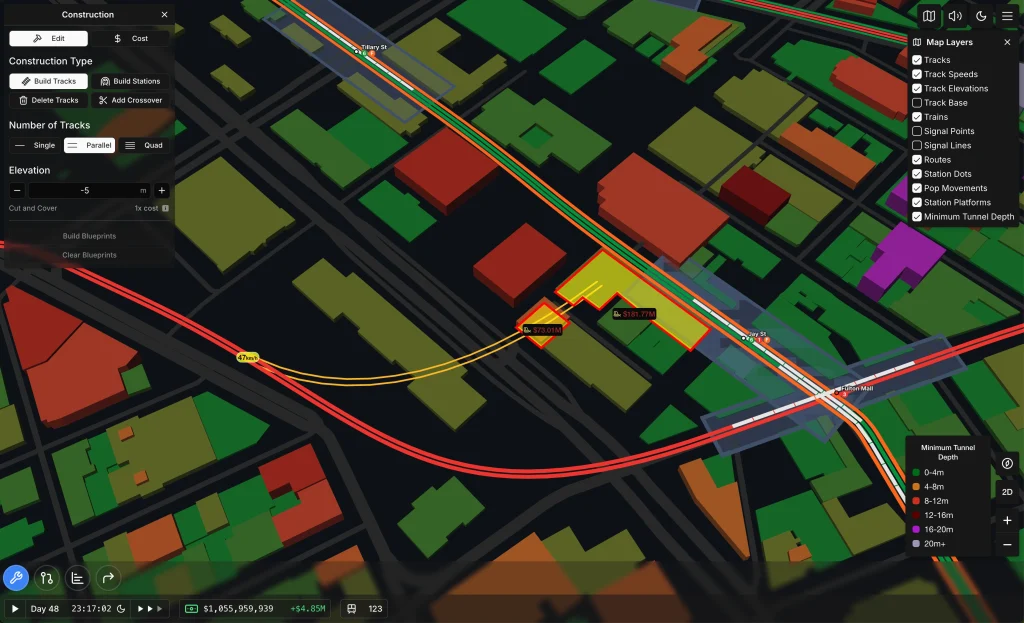
Finally, and this could just be because I am playing on a MacBook Pro: I do run into the occasional crash or inability to refresh. I have noticed that these bugs get resolved fairly quickly with each new update, so I am hopeful we’ll be able to see some quality-of-life improvements!! For example, I’d love to see the tutorial improved or perhaps an easier method of designing layered tracks, but overall it runs well and the controls are easy to use. The developer roadmap shares a vision for “improved visualization tools” and “detailed passenger flow analysis” along with cities outside of the United States and, eventually, a launch on Steam.
These are small issues, and honestly, it’s impressive the game has run so well since launch, especially given it’s being built by a solo developer, Colin Miller, as what appears to be a side project. Miller’s website shows other tech projects, most of which are not games. So, I’m not sure if he set out to make something this ambitious or if it was just a simple pet project that grew into something fun, challenging, and special, but I’m glad it exists regardless. It feels like this could just be the beginning, too. There is a huge opportunity for more maps. Hopefully, the minor problems will someday be a thing of the past as the user base grows.
Please Listen Up for an Important Message
Subway Builder understands an important thing: It is fun to build trains. As I watched my new lines run wild and revenue skyrocketed, I was having a great time. But the game also understands something far more important: Good public transit fosters stronger communities. To be able to cross all of New York in a matter of minutes opens up countless opportunities for the whole region to seek out new career avenues, creative places to eat and drink, or simply an afternoon trip to Central Park. The costs of cars, not to mention gas, parking, or even traffic, only serve to hold us back and divide us from communal, human experiences. A city built on transit prevents us from relegating ourselves to our homes and treating travel as a burden. It allows us to connect, grow, and improve our quality of life.
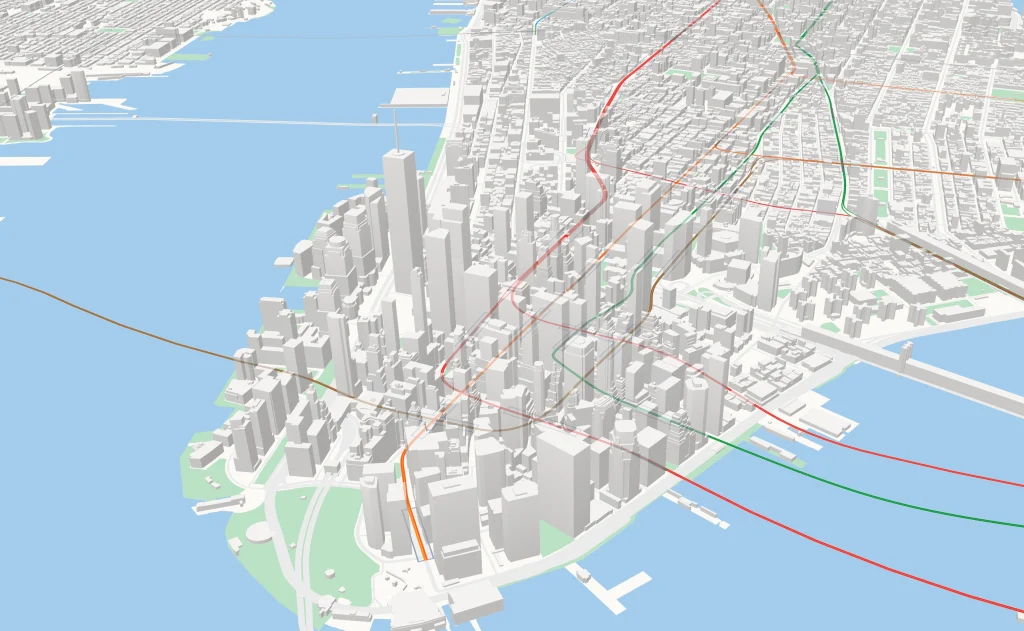
For these reasons, I am grateful to have come across Subway Builder. It isn’t just a game, but also an inspiring lesson in infrastructure and community. So many cities across America suffer from a lack of quality public transit and become nothing more than big towns. Our greatest cities are those that are interconnected, and my hope is that Subway Builder can inspire its players to get invested in real-life infrastructure, looking for new ways to get people from one place to another in a way that integrates them into the fabric of a city. Subway Builder is a great video game on its own. Its broader morals, though, are what set it apart for me as something more than that. It is a lesson in how we can build better tomorrows.
On Track
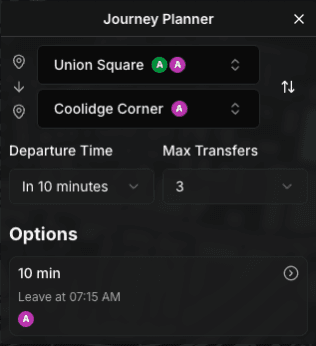
While Subway Builder may be less appealing to those who don’t frequent the train and/or simulator genres, it’ll surely be a hit with anyone who does. Miller’s year-long roadmap of upcoming updates to advance the game from its current public beta to an official launch ensures that it’ll have plenty of time to pick up steam — and passengers.
Oh, and as for my dream to take a train to the movies… Well, I was able to build a line that got me from my house to the Coolidge Corner Theater in just 10 minutes. Not too shabby at all for a day at the movies!
Score: 8.5/10
Subway Builder, developed by Colin Miller, released in a public beta on October 9, 2025, for PC, MacOS, and Linux via www.subwaybuilder.com. MSRP: $30.00. Version reviewed: MacOS.
Disclaimer: A review code was provided by the developer.
Mark is a contributor to The Punished Backlog, often promising articles and occasionally delivering when he actually commits to it. Mark games mainly on his PS5 and his Switch, and some of his favorite games include God of War, Ghost of Tsushima, The Witcher 3: Wild Hunt, and his all time favorite, Red Dead Redemption 2. When not gaming, Mark is an avid fan of all Boston sports teams and his Villanova Wildcats. He also loves hiking, skiing, and traveling across the U.S.

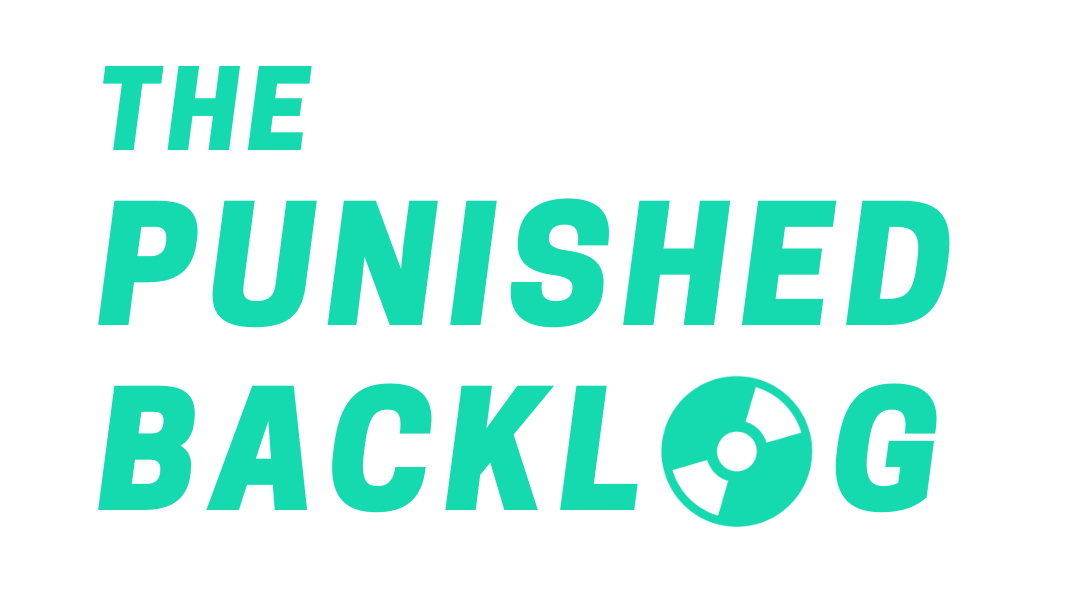
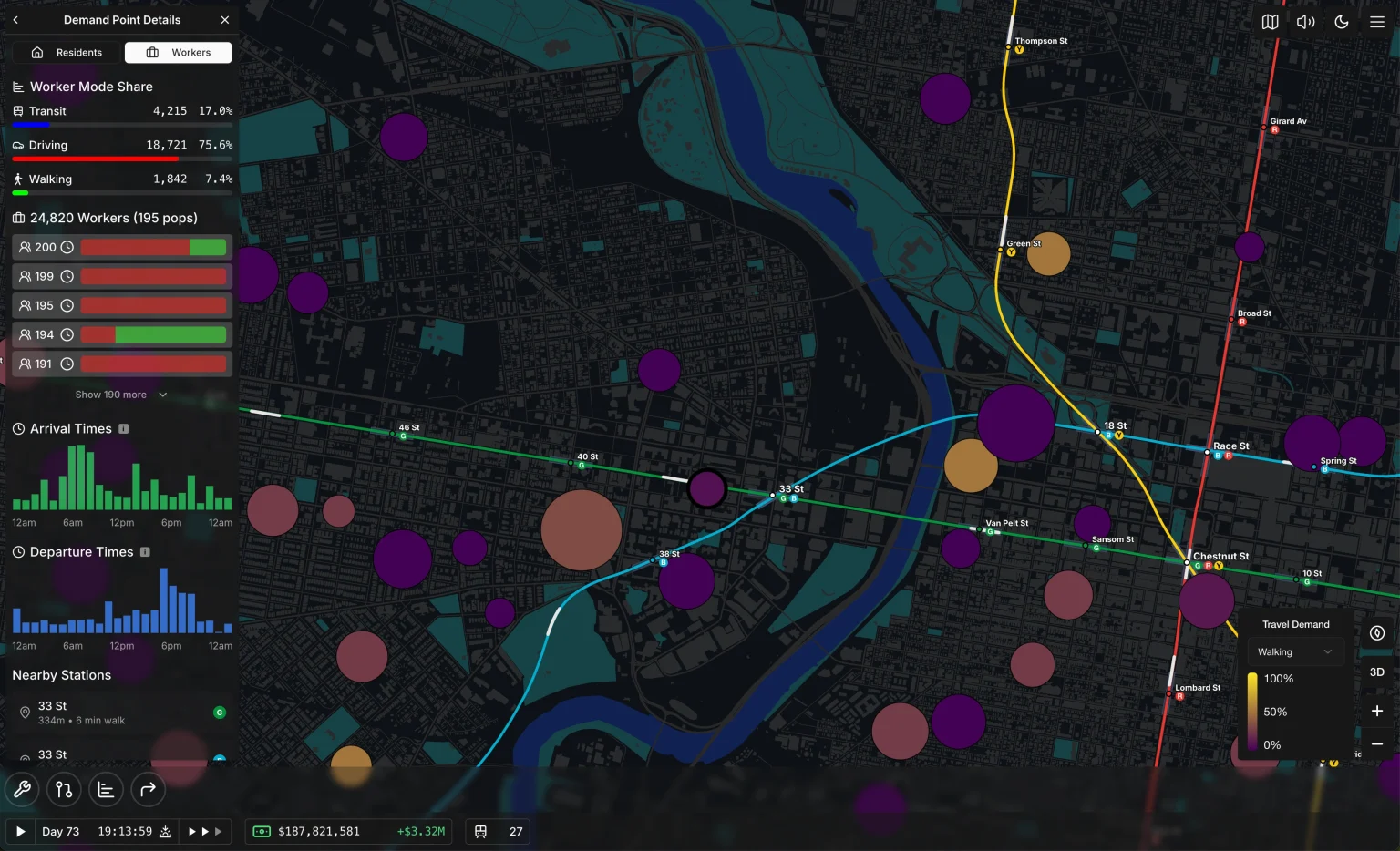



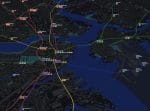

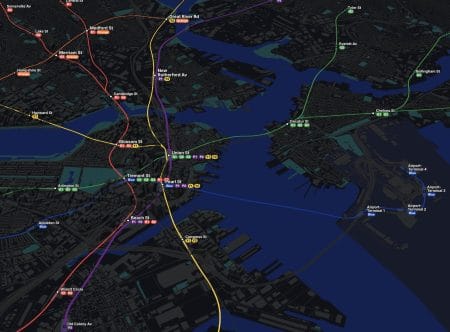
1 Comment
Every time I’ve been helped and/or failed by public transit over the past few weeks (often), I think about this review.